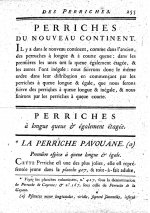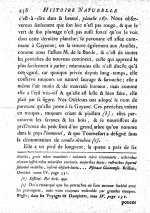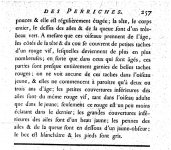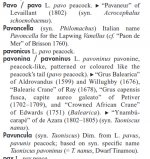Björn Bergenholtz
(former alias "Calalp")

Let´s take a look at another tricky Bird name, this time regarding the White-eyed Parakeet Aratinga leucophthalma STATIUS MÜLLER 1776… in French Conure (Perriche/Perruche) pavouane. And it is that pavouane I´m trying to understand!
This Parakeet was described by the great French ornithologist Buffon, in his Histoire Naturelle des Oiseaux 1779, on pp. 255-257 (Attached). As usual for Buffon without any such Nonsense as binary names, linnean ideas or unnecessary Latin (French was good enough!) – as ”La Perriche pavouane”. His only motivation for the name (as far as I can tell) was the short sentence:
And; does the rest of those Buffon pages tells us anything more regarding why he called it so?
The same species also got accounted for by Latham in 1781 as the "Pavouane Parrot" and (according to several sources) by Boddaert in 1783 as "Psittacus pavua". For the latter see link (here)!? Page 10.
In 1801 Buffons fellow countryman Levaillant even tried to establish the name "Ara Pavouanne” (with double-n, this time) for the same Parakeet, but it was never any success. Especially not after the ascertainment that the "pavouan(n)e" already got its current scientific name leucophthalma (as "Psittacus leucophthalmus") by Statius Müller in 1776. Chronological priority rule, and the " pavouane/pavouanne" simply disappeared from Scientific nomenclature, but managed to cling on, at least in its French Common name (… and in its Swedish aviary "Pet" name "pavuaparakit") .
Anyone know what that Pavouanne alt./or Pavua mean?
This Parakeet was described by the great French ornithologist Buffon, in his Histoire Naturelle des Oiseaux 1779, on pp. 255-257 (Attached). As usual for Buffon without any such Nonsense as binary names, linnean ideas or unnecessary Latin (French was good enough!) – as ”La Perriche pavouane”. His only motivation for the name (as far as I can tell) was the short sentence:
Anyone feel like translating that short quote for me!? If so, please as accurate as possible, as I would like to quote it myself in Swedish. And don´t hesitate to remark on any errors that I might have done transcribing it.”Nos Oisseleurs ont adopté le nom de pavouane qu’elle porte à la Guyane.”
And; does the rest of those Buffon pages tells us anything more regarding why he called it so?
The same species also got accounted for by Latham in 1781 as the "Pavouane Parrot" and (according to several sources) by Boddaert in 1783 as "Psittacus pavua". For the latter see link (here)!? Page 10.
In 1801 Buffons fellow countryman Levaillant even tried to establish the name "Ara Pavouanne” (with double-n, this time) for the same Parakeet, but it was never any success. Especially not after the ascertainment that the "pavouan(n)e" already got its current scientific name leucophthalma (as "Psittacus leucophthalmus") by Statius Müller in 1776. Chronological priority rule, and the " pavouane/pavouanne" simply disappeared from Scientific nomenclature, but managed to cling on, at least in its French Common name (… and in its Swedish aviary "Pet" name "pavuaparakit") .
Anyone know what that Pavouanne alt./or Pavua mean?
Attachments
Last edited:









